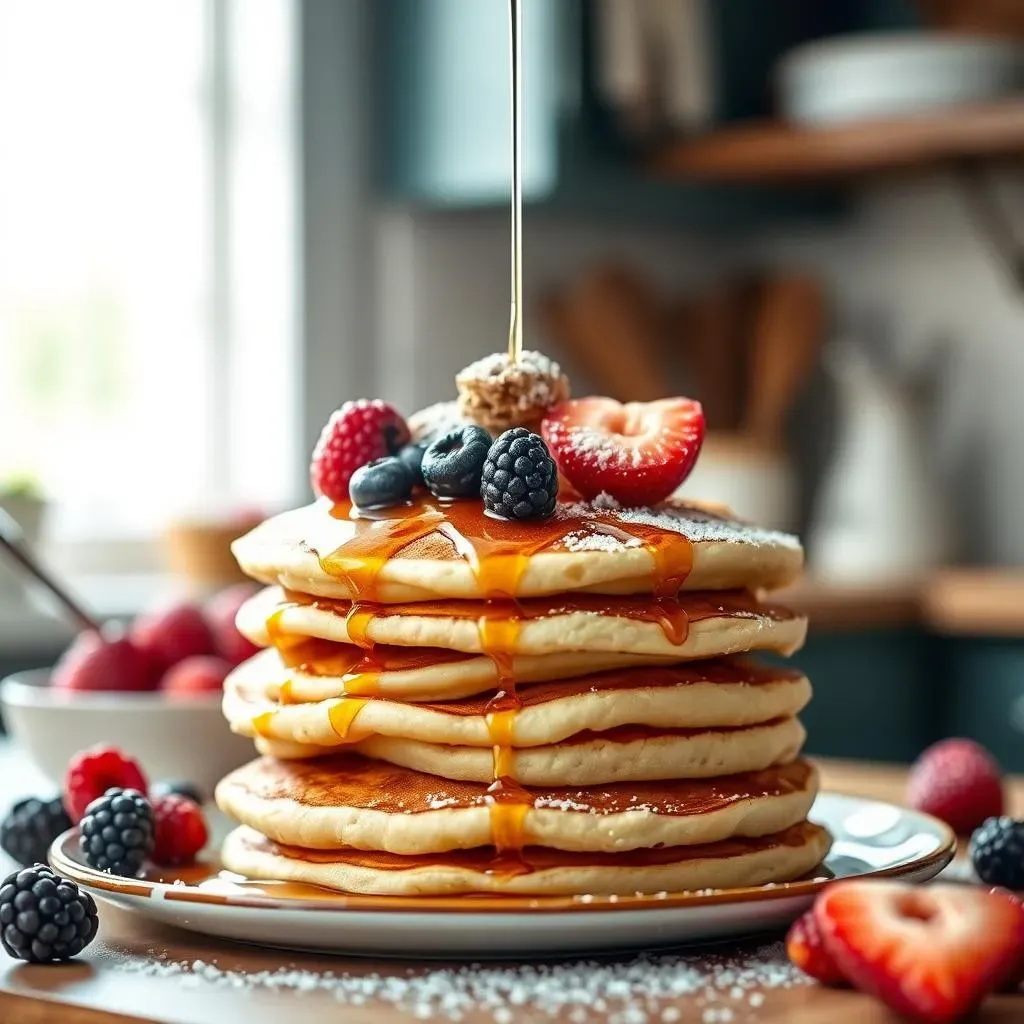Table of Contents
Tired of complicated gluten-free recipes that take forever? What if I told you that you could whip up a batch of fluffy, delicious pancakes with minimal effort? That's where the magic of a blender comes in! This isn't just another gluten-free pancake recipe; it’s a game-changer. We're talking about a "gluten-free pancake recipe made with a blender" that's so simple, even a kid could make it. No more sifting, whisking, or complicated steps, just throw everything in the blender, and you're good to go. I'll walk you through the easy steps, from gathering your ingredients to flipping golden-brown pancakes. We'll tackle common issues, share some fun add-in ideas, and talk about how to store any leftovers (if you have any!). Get ready to ditch the fuss and embrace the ease of blender pancakes. It’s time to make breakfast fun, quick, and totally gluten-free.
Why Use a Blender for GlutenFree Pancakes?
Why Use a Blender for GlutenFree Pancakes?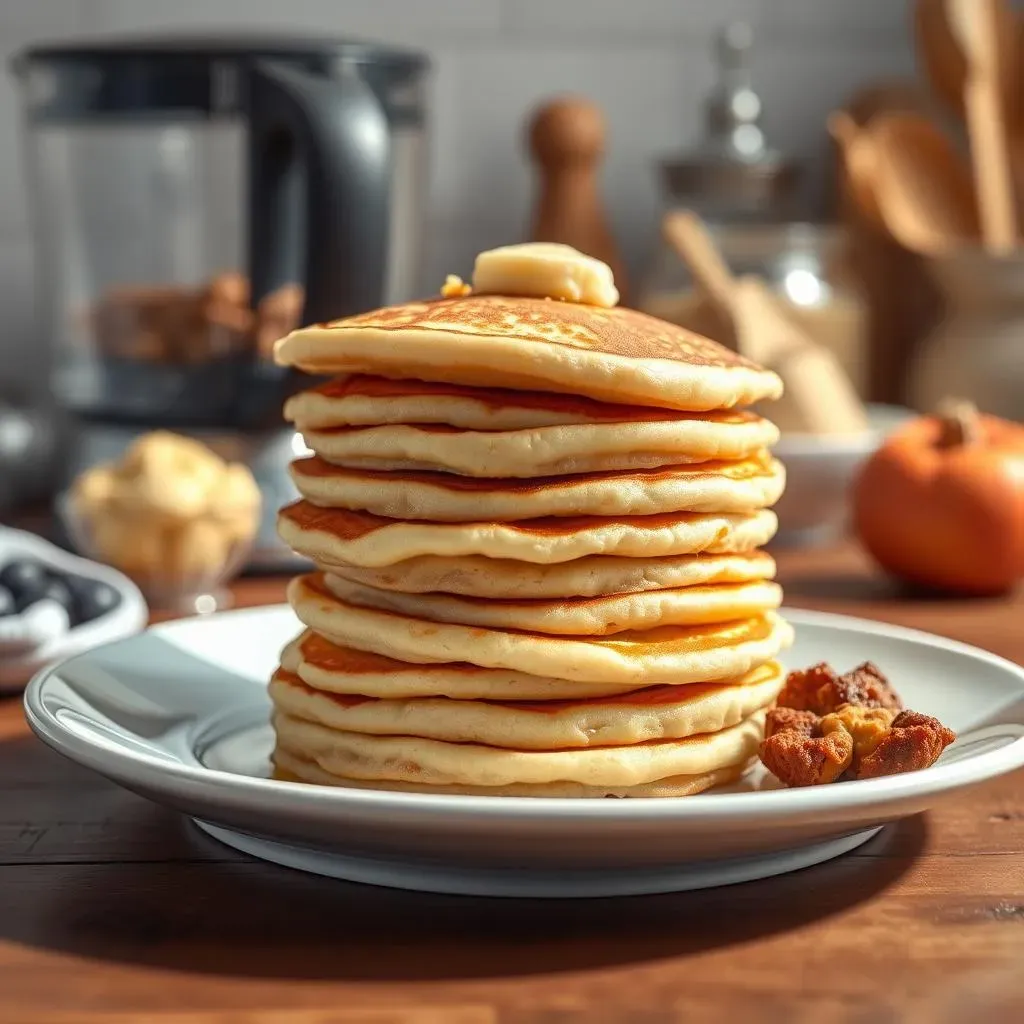
Okay, so you're wondering, "Why a blender?" when making gluten-free pancakes, right? I get it. It might seem like an unnecessary step. But trust me, it's a total game changer. First off, it's about speed. You can dump all your ingredients into the blender, press a button, and boom – the batter is ready. No more tedious whisking or worrying about lumps. It’s perfect for those busy mornings when you need a quick breakfast. Also, using a blender helps achieve a super smooth batter, which translates to light and fluffy pancakes. It evenly distributes the ingredients, so you won't end up with pockets of flour or baking powder. And let's be real, who wants gritty pancakes?
Plus, for anyone who is just starting out with gluten-free cooking, a blender takes away a lot of the guesswork. It's like having a little kitchen helper that ensures everything is perfectly combined. This method is particularly helpful when you're working with gluten-free flours, which can sometimes be a bit finicky. If you are looking for a easy gluten-free pancake recipe for beginners, the blender method is your best bet. It’s also great if you're looking to sneak in some healthy ingredients, like bananas, without ending up with chunks in your batter. It's all about ease and consistency, my friend.
Benefit | Description |
|---|---|
Speed | Quick batter preparation, perfect for busy mornings |
Smooth Batter | Eliminates lumps and ensures even ingredient distribution |
Consistency | Reliable results every time, great for gluten-free flours |
Easy incorporation | Makes it easy to add fruit or other ingredients |
I remember the first time I tried making gluten-free pancakes without a blender. It was a disaster! The batter was lumpy, the pancakes were dense, and honestly, they tasted a bit like sadness. Then I tried the blender method, and it was like a light bulb went off. The difference was night and day. The pancakes were light, airy, and actually tasted good! If you're aiming for that perfect texture, the blender is absolutely the way to go. Have you ever tried to use a blend of flours? This method works great for pancakes with a blend of flours too.
The Simple Ingredients You'll Need
The Simple Ingredients You'll Need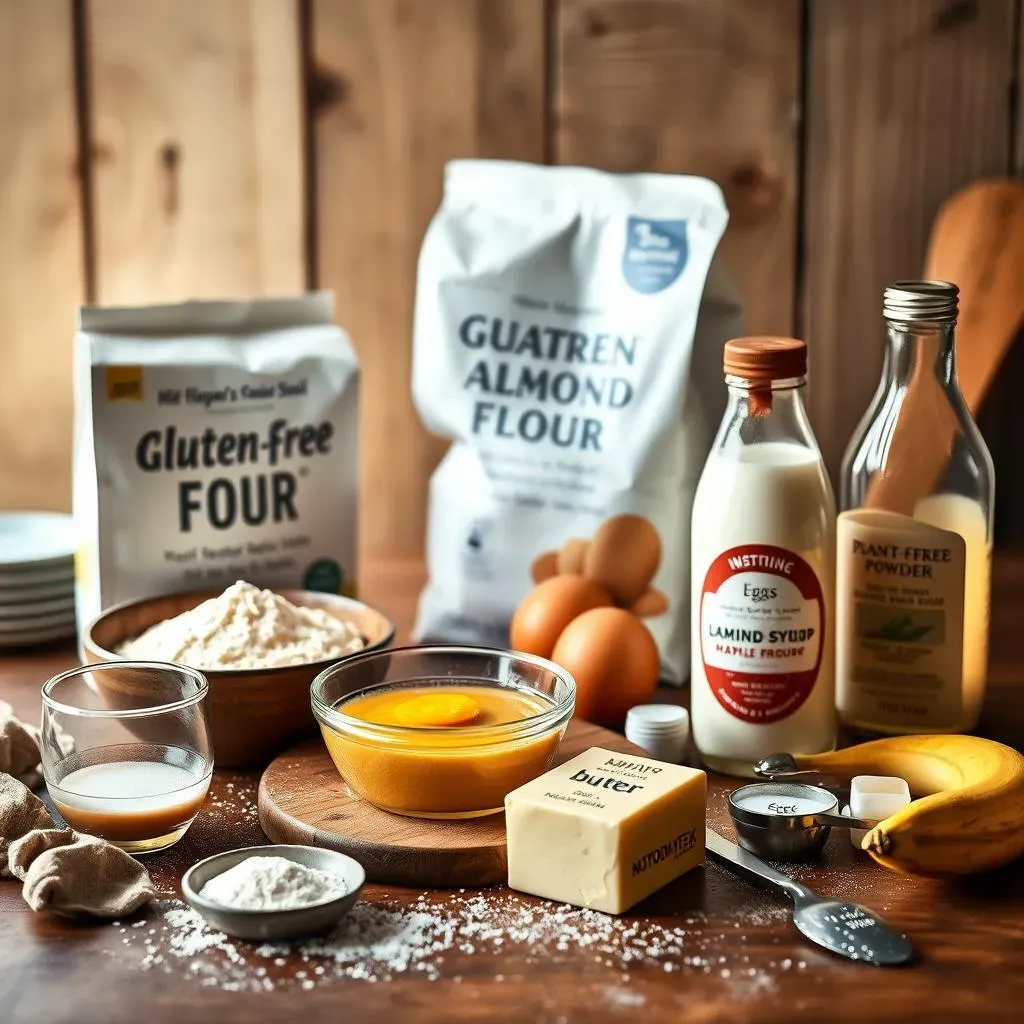
The Foundation: Flours and Binders
Alright, let's talk ingredients. Don't worry, we're keeping it simple. For this blender pancake magic, you'll need a good gluten-free flour blend. I like using a mix of oat flour and almond flour, it gives a nice texture and flavor, but you can use your favorite blend. If you're avoiding nuts, try a blend with rice flour, or tapioca starch. You'll also need a binding agent. Eggs are great for this, but if you're looking for an egg-free version, flaxseed meal or chia seeds are fantastic alternatives. These help hold the pancakes together. Remember, the right flour blend is key to a successful gluten-free pancake, so choose wisely.
You'll also want to add some leavening to get those pancakes nice and fluffy. Baking powder is your best friend here. It gives the pancakes a lift and makes them airy. A pinch of salt is also crucial for enhancing the flavors. Don’t skip it! And for a touch of sweetness, I usually use maple syrup. However, you can use honey, or even a sugar alternative if you prefer. If you want to use honey check out gluten-free pancakes with honey. The goal is to have a balanced flavor profile that isn't too sweet or bland. These simple ingredients will create a delicious base for your pancakes, and you can always add more fun stuff later, but for now, let’s keep it simple.
Ingredient | Purpose |
|---|---|
Gluten-Free Flour Blend | Provides structure and texture |
Eggs or Flax/Chia Seeds | Binds the ingredients together |
Baking Powder | Leavens the pancakes, making them fluffy |
Salt | Enhances the flavors |
Maple Syrup or Sweetener | Adds sweetness |
The Wet Stuff: Liquids and Flavor
Now, for the wet ingredients. You'll need some kind of milk. I like using plant-based milk, like almond milk, or oat milk. It’s great for keeping things dairy-free, but feel free to use regular milk if you prefer. The milk adds moisture to the batter, making it easy to blend. Plus, it helps to create a nice, smooth consistency. Next up, we need some fat. Melted dairy-free butter or coconut oil works great. The fat adds richness and helps the pancakes get that perfect golden-brown crust. If you need a dairy-free option, be sure to check out gluten-free pancakes with dairy-free options. And finally, for an extra layer of flavor, I like to add a ripe banana. It makes the pancakes naturally sweet and gives them a lovely banana taste. You can also add a teaspoon of vanilla extract for an extra touch of flavor. All these wet ingredients are crucial for creating that perfect batter that blends up beautifully.
These ingredients are not just about function; they’re also about flavor. The ripe banana adds a natural sweetness and a hint of fruitiness that really elevates the pancakes. The melted butter or oil not only adds richness but also helps with that beautiful golden-brown color when they cook. And the vanilla? Well, that's just pure magic. It's like a little secret ingredient that makes everything taste better. Remember, the goal is to create a balanced batter that's not too thick or thin. If you are looking for other options, you can use gluten-free pancake recipe using banana. If you find the batter is too thick, just add a little more milk until you get the right consistency. This is your canvas, so have fun with it!
- Plant-Based Milk (almond, oat, etc.)
- Melted Dairy-Free Butter or Coconut Oil
- Ripe Banana
- Vanilla Extract (optional)
StepbyStep: Making Pancakes in a Blender
StepbyStep: Making Pancakes in a Blender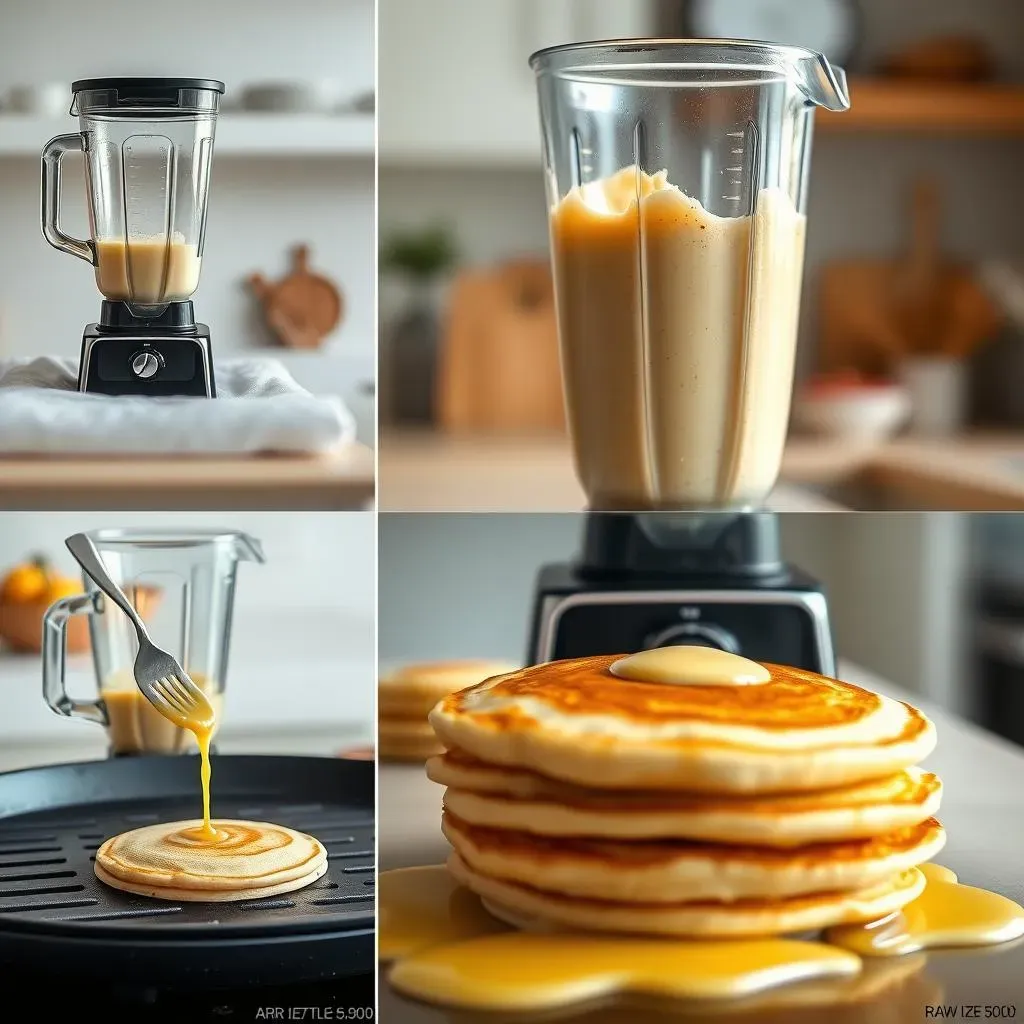
Blending the Batter
Okay, now for the fun part! Making the batter is ridiculously easy. First, grab your blender. I like to start with the wet ingredients, so pour in your plant-based milk, melted dairy-free butter or coconut oil, and the ripe banana. If you are using vanilla extract, add that now as well. Then, crack in your eggs, or add your flaxseed or chia seed mixture if you're going egg-free. Blend these together until everything is nice and smooth. This usually takes about 30 seconds or so. You want to make sure there are no banana chunks left.
Next, add in all the dry ingredients: your gluten-free flour blend, baking powder, and salt. Blend again until everything is just combined. You don't want to over-blend, just mix it until the flour is incorporated and the batter is smooth. If you find your batter is too thick, add a little more milk, one tablespoon at a time, until you reach your desired consistency. It should be pourable but not too runny. If you are new to gluten-free baking, you might find this method much easier than the traditional way. If you are looking for a gluten-free pancake for a quick breakfast, this will be your go-to method.
Step | Action |
|---|---|
1 | Combine wet ingredients in blender |
2 | Blend until smooth |
3 | Add dry ingredients |
4 | Blend until just combined |
Cooking the Pancakes
Alright, your batter is ready, and now it’s time to cook these beauties. Heat a lightly oiled griddle or non-stick pan over low to medium heat. It’s important not to crank the heat up too high, or your pancakes will burn on the outside while remaining raw inside. Once the pan is warm, pour about 1/4 cup of batter onto the hot surface for each pancake. You can make them any size you want, but I like to keep them around 4 inches. I like to use a griddle because it helps me cook more at the same time.
Cook the pancakes for about 2-3 minutes per side, or until golden brown. You’ll know it’s time to flip them when you see bubbles forming on the surface and the edges start to look cooked. Use a spatula to carefully flip each pancake and cook the other side for another 1-2 minutes. Once they're cooked, transfer them to a plate, and repeat with the remaining batter. If you’re feeling adventurous, you can try adding some chocolate chips or berries to the batter. If you need a recipe that is good for special occasions, try the gluten-free pancake for special occasions. These blender pancakes are so easy to make, you'll be whipping them up every weekend.
- Heat griddle or pan over low-medium heat
- Pour 1/4 cup of batter for each pancake
- Cook 2-3 minutes per side
- Flip when bubbles form on the surface
- Cook until golden brown
Tips for Perfect GlutenFree Blender Pancakes
Tips for Perfect GlutenFree Blender Pancakes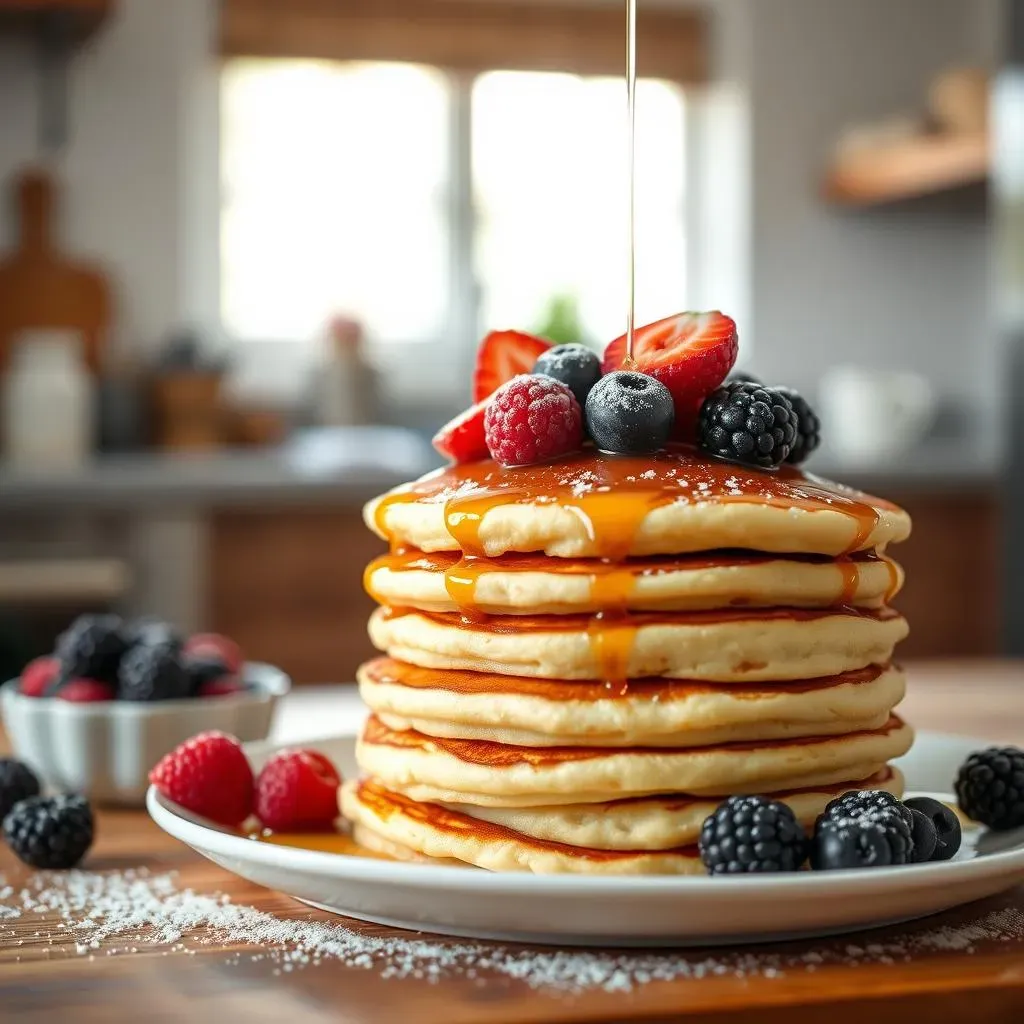
Mastering the Batter Consistency
Okay, let's talk batter. The consistency is key to getting those perfect, fluffy pancakes. You want your batter to be pourable, but not too runny. If it’s too thick, your pancakes will be dense. Too thin, and they’ll spread out like crepes. The best way to check is to lift your blender blade and see how the batter runs off of it. It should be thick enough to coat the back of a spoon, but still flow easily. If you need to adjust, add milk one tablespoon at a time until you get it right. This step is crucial, so don't rush it. If you are looking for a guide, check out gluten-free pancake recipe troubleshooting for more help.
Remember, gluten-free flours can behave differently than regular flour, so you might need to tweak the liquid a bit each time you make the recipe. It's all about getting to know your ingredients. I’ve had my share of batter mishaps, from pancake batter that was like cement to one that was practically water. It’s all part of the learning process. The good news is that once you get the hang of it, it becomes second nature. Do not be afraid to experiment a little to see what works best for you and your blender. It’s a good idea to start with the recipe as is, and adjust from there.
Problem | Solution |
|---|---|
Batter too thick | Add milk, 1 tbsp at a time |
Batter too thin | Add flour, 1 tbsp at a time |
Batter is lumpy | Blend a little longer |
The Heat is On: Cooking Like a Pro
Alright, let's move on to cooking. The heat of your pan is super important. You want to use medium-low heat. Too hot, and your pancakes will burn on the outside before they're cooked on the inside. Too low, and they’ll take forever to cook and won't get that nice golden-brown color. So, medium-low is the sweet spot. Let the pan heat up properly before you start cooking. A good test is to sprinkle a few drops of water on the pan. If they sizzle and evaporate quickly, it's ready to go. If you are looking to do this on a weekend, check out gluten-free pancake recipe for a weekend brunch, you have more time to practice.
Also, don't overcrowd the pan. Leave some space between each pancake. This will allow them to cook evenly. I usually cook about three at a time, depending on the size of my pan. Once you pour the batter, resist the urge to flip them too soon. Wait until you see bubbles forming on the surface and the edges start to look set. This is when you know it’s time to flip. Use a thin spatula to gently flip them over, and cook for another minute or two on the other side. The goal is to get a nice golden-brown color on both sides. If you are making these for toddlers, try to make the batter a little thicker, so they do not spread out too much. Check out gluten-free pancake recipe for toddlers for more inspiration.
"The secret of getting ahead is getting started." - Mark Twain
Adding the Extra Touch
So, you've got the batter and the cooking down, but what about those little extra touches that make your pancakes truly special? Well, don't be afraid to experiment with add-ins. Chocolate chips, blueberries, or even a sprinkle of cinnamon can really elevate your pancakes. You can add them directly to the batter or sprinkle them on top after you pour the batter on the pan. I usually like to add a little lemon zest to the batter. It gives the pancakes a nice little zing. If you are looking to add some protein, you can try gluten-free pancake recipe with protein powder.
Another great tip is to use a good quality non-stick pan. It makes flipping the pancakes much easier and reduces the risk of them sticking to the pan. If you don’t have a non-stick pan, make sure to use a good amount of oil or butter to grease the pan. And finally, remember to be patient. Don't rush the cooking process. Good pancakes take a little time and care. Once you have mastered this, you will be amazed at how quick and easy it is to make delicious gluten-free pancakes using the blender method. If you're looking to make it more exciting, try gluten-free pancake recipe with berries.
- Add chocolate chips or berries
- Sprinkle cinnamon
- Use a non-stick pan
- Be patient while cooking
Variations and Addins to Try
Variations and Addins to Try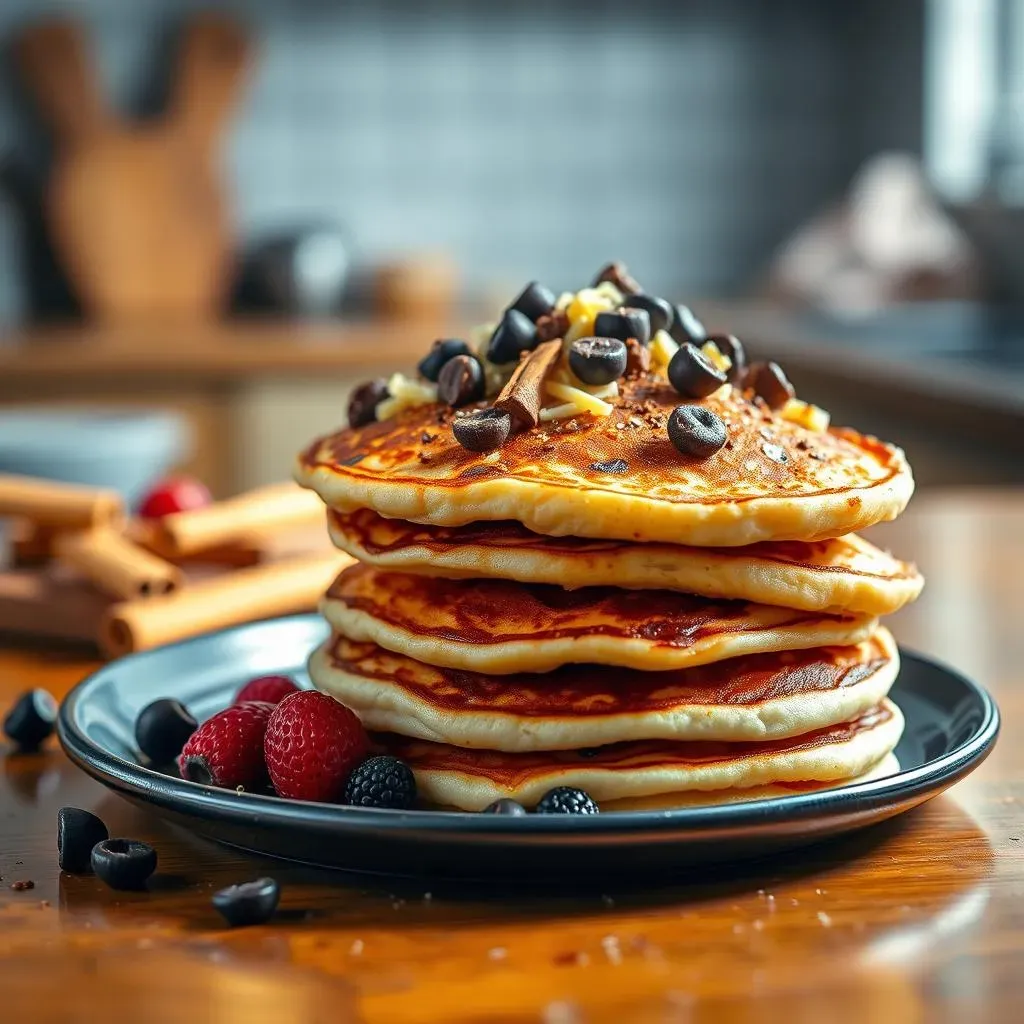
Sweet Sensations: Adding Flavor
Alright, let's get creative! You've nailed the basic blender pancake, now it's time to have some fun with flavors. Think of your pancake batter as a blank canvas, ready for your culinary masterpiece. If you’re looking for a classic, try adding a handful of chocolate chips to the batter before cooking. The melty chocolate is a total game changer. Or, for a burst of freshness, toss in some blueberries or raspberries. You can even use a mix of berries for a more complex flavor. If you want to add a hint of warmth, try adding a dash of cinnamon or nutmeg. It will make your kitchen smell amazing and add a cozy flavor to the pancakes. You can also use different extracts, like almond or lemon, to add a little something special. If you are looking for a recipe that is good for kids, check out gluten-free pancake recipe for kids.
If you are looking for something a little more decadent, try adding a tablespoon of cocoa powder to the batter for a chocolatey twist. You can also add a swirl of peanut butter or Nutella to the batter before cooking for a delicious treat. Another great idea is to add a little bit of shredded coconut for a tropical vibe, or a few chopped nuts for some crunch. And if you’re feeling adventurous, you can even add a little bit of citrus zest, like lemon or orange, to the batter. It really brightens up the flavor and adds a nice little zing. The possibilities are endless, so don't be afraid to experiment and find your favorite flavor combinations. Remember, the goal is to make your pancakes taste exactly the way you like them. If you need some inspiration on using different flour, check out gluten-free pancakes with rice flour.
Add-in | Flavor Profile |
|---|---|
Chocolate Chips | Classic, melty, sweet |
Berries | Fresh, fruity, slightly tart |
Cinnamon/Nutmeg | Warm, cozy, aromatic |
Cocoa Powder | Rich, chocolatey |
Coconut | Tropical, nutty |
Savory Swirls: Thinking Outside the Sweet Box
Okay, so maybe you're not always in the mood for sweet pancakes. That's totally fine! You can definitely make some amazing savory pancakes using this blender method. One of my favorite ways to do this is by adding some herbs and spices to the batter. Try adding some chopped chives, dill, or parsley. You can also add a little bit of garlic powder or onion powder for a savory kick. For a cheesy twist, add a tablespoon or two of grated cheese to the batter. Cheddar or Parmesan work great. You can also use a combination of cheeses for a more complex flavor. If you are looking for a recipe that is good for sensitive stomachs, try gluten-free pancake recipe for sensitive stomachs.
If you want to make it even more substantial, try adding some cooked veggies to the batter. Spinach, mushrooms, or bell peppers are all great options. Just make sure they are finely chopped so they mix well. You can also add some cooked bacon or sausage for a protein boost. And if you're feeling really adventurous, try adding a little bit of hot sauce for a spicy kick. The great thing about savory pancakes is that you can get really creative. It's all about experimenting and finding flavor combinations that you love. Don't be afraid to try out some new and exciting ingredients. You might just surprise yourself with how delicious savory pancakes can be. You can also use flaxseed meal as a binder, check out gluten-free pancake recipe with flaxseed meal.
- Chopped herbs (chives, dill, parsley)
- Garlic or onion powder
- Grated cheese (cheddar, parmesan)
- Cooked veggies (spinach, mushrooms)
- Cooked bacon or sausage
Serving and Storing Your Blender Pancakes
Serving and Storing Your Blender Pancakes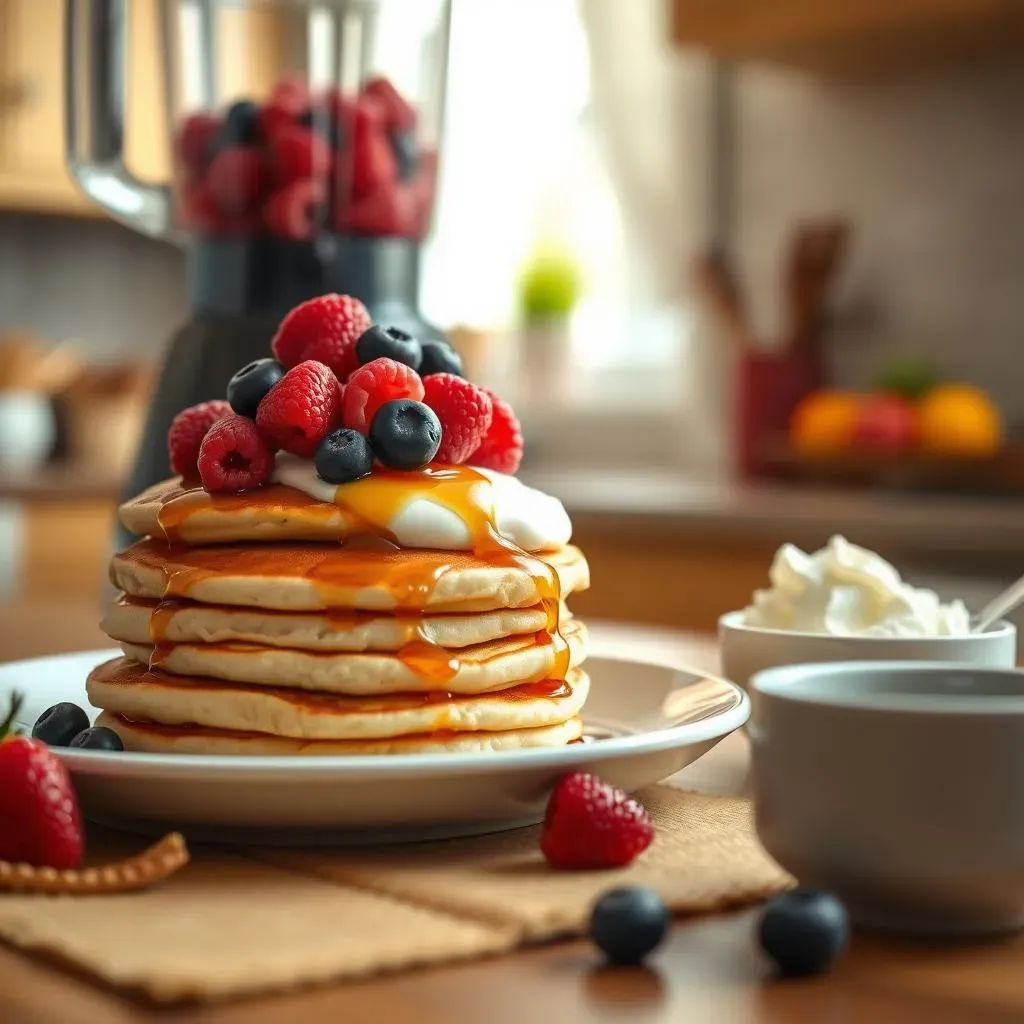
Serving Suggestions: The Fun Part
Okay, so you've got a stack of beautiful, fluffy blender pancakes. Now what? Well, this is where you get to be creative! Serving is all about making those pancakes extra special. For a classic approach, a drizzle of maple syrup is always a winner. But don't stop there! Try adding a dollop of yogurt or whipped cream for extra richness. Fresh berries, like strawberries, blueberries, or raspberries, add a burst of flavor and color. You can also add a sprinkle of chopped nuts for some crunch. If you want to make it a little more decadent, try adding a scoop of ice cream or a drizzle of chocolate sauce. The options are endless, so have fun with it. If you are looking for a recipe that is quick to make, check out gluten-free pancakes for a quick breakfast.
Another great idea is to create a pancake bar where everyone can customize their own toppings. This is a great idea for a weekend brunch or a family gathering. You can set out a variety of toppings, like different kinds of fruits, nuts, syrups, and sauces. Let everyone build their own masterpiece. You can also try adding a side of crispy bacon or sausage for a savory element. Or, if you’re feeling fancy, try serving your pancakes with a side of lemon curd or compote. Remember, the goal is to make your pancakes a memorable experience. So, don't be afraid to experiment and find your favorite combinations. You can also use plant-based milk, check out gluten-free pancakes with plant-based milk.
Topping | Why It Works |
|---|---|
Maple Syrup | Classic sweetness |
Fresh Berries | Fruity, fresh, colorful |
Yogurt or Cream | Rich, creamy |
Chopped Nuts | Crunchy texture |
Chocolate Sauce | Decadent, sweet |
Storing Leftovers: Keeping the Goodness
So, you've made a big batch of pancakes, and you've got some leftovers. No problem! These blender pancakes store really well. If you plan to eat them within a couple of days, you can store them in an airtight container in the refrigerator. They’ll stay fresh for 2-3 days. When you're ready to reheat them, you can pop them in the microwave for a few seconds, or you can warm them up in a toaster oven. They also reheat well in a pan on the stovetop. Just add a little butter or oil to the pan and cook them for a few minutes on each side until they’re heated through. If you are looking for a recipe that is good for weight loss, check out gluten-free pancakes for weight loss.
If you need to store them for longer, you can freeze them. Let the pancakes cool completely, then place them in a single layer on a baking sheet. Freeze them for about an hour, then transfer them to a freezer-safe bag or container. This prevents them from sticking together. They’ll keep well in the freezer for up to a month. When you're ready to eat them, you can reheat them directly from frozen in the microwave or toaster oven. Freezing is a great way to have pancakes ready for a quick breakfast anytime. You can also try making pancakes without eggs, check out gluten-free pancakes without eggs.
- Store in fridge for 2-3 days
- Reheat in microwave or toaster oven
- Freeze for up to 1 month
- Freeze in a single layer
"The best way to predict your future is to create it." - Abraham Lincoln
Wrapping Up: Your Gluten-Free Pancake Journey
So, there you have it – a super easy, super fast, and super delicious gluten-free pancake recipe made with a blender. No more excuses for skipping breakfast or settling for sad, dense pancakes. This method is a game-changer, whether you're a seasoned gluten-free baker or just starting out. Remember, the key is to have fun with it, experiment with different flavors, and enjoy the process. You've now got the secret weapon to make mornings a little brighter and a lot tastier. Now go on, impress your friends, family, or just yourself with a stack of perfect gluten-free blender pancakes. And don't forget to check out other easy gluten-free recipes, like our best gluten-free pancake recipe for celiacs, for more breakfast inspiration. Happy flipping!
